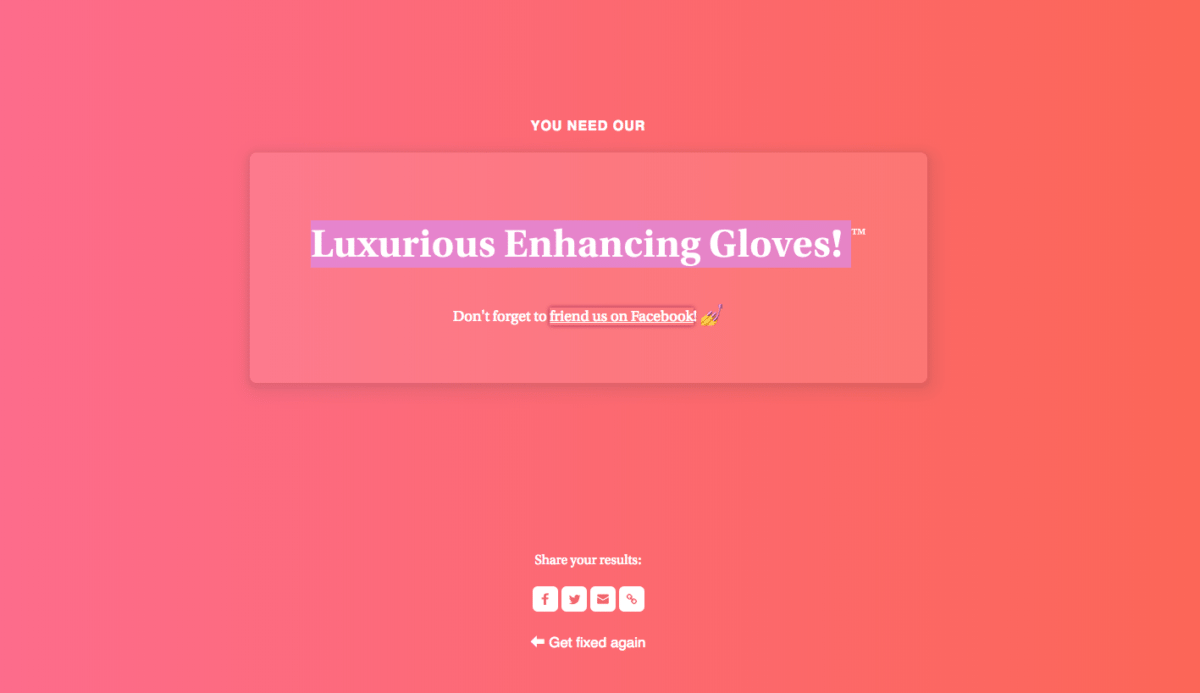Click on the website and a round loading graphic will appear.
At the center of the hovering graph, the word “Analyzing” stares at you, as if detecting your issues via retinal scan. Then, “Problem Bodies,” a site built by Stitch product designer Lauren Hallden, hits you with the piercing question:
“Is your one inadequate fingernail making it hard to date?”
Problem Bodies serves up an endless stream of seemingly made-up problems your body could have (Bulbous pores? Dinky biceps?) and then immediately offers up a link to the magic solution that you can, of course, buy (Pore Disguisers! Super-Refreshing Bicep Re-Energizer!).
Though in a playful way, the site delivers a poignant criticism of digital marketing, and society overall. Hallden wrote in a Medium post that the website was her response to the constant scrutiny under which our bodies (but mostly, the female body) are subjected to by targeted online advertising.
“No part is spared, and no appearance is the correct one,” the Port Richmond developer wrote. “Women are trying to get more muscular, and also thinner. Trying to get rounder butts and smaller butts. Bigger hair and calmer hair. There are products to whittle your eyebrows down, and then more products to paint in what’s left to ensure they stand out.”
The project also has roots in Hallden’s post on her bra-riddled Instagram feed, which went viral earlier this year.
“We know that women’s bodies being problematized, and divided into parts that need fixing, isn’t new,” Hallden told Technical.ly in an email. “As women started to make progress toward greater social equality and an improved financial situation, the hammer of unrealistic expectations fell pretty quickly — you can work as a flight attendant or a secretary, fine, but only if you’re under a certain weight, and you wear attractive clothing, and you act like a model. And you stay young. It *seems* like we’ve come a long way since then. And yet every time I peek at Instagram, the ads I see are extremely thin, young, often headless or half-dressed women.”
https://twitter.com/phillylauren/status/977980285265629186
It seems, Hallden said, that there’s always more work to be done for women in order to meet societal expectations. And normal features, like having breasts with certain shapes, are made to look like a problem to be fixed.
“It plants this idea in your head that you’re doing it wrong, your body needs more products,” Hallden said.
https://twitter.com/phillylauren/status/1036921026205175808
An actionable takeaway from the developer’s website? The similarity between the site’s wacky, algorithm-generated copy and actual ads running on social platforms should make online marketers and technologists building those platforms rethink their approach to the human body.
“I think advertisers really need to take a hard look at the kinds of images they’re presenting,” Hallden said. “I’m spending less and less time on places like Instagram, because there’s no easy way to tune your ad experience to show you fewer images like this. If every time you log in, eight people rush to suggest things about your body that you could ‘fix’, maybe not logging in is the healthiest choice.”
Before you go...
Please consider supporting Technical.ly to keep our independent journalism strong. Unlike most business-focused media outlets, we don’t have a paywall. Instead, we count on your personal and organizational support.
3 ways to support our work:- Contribute to the Journalism Fund. Charitable giving ensures our information remains free and accessible for residents to discover workforce programs and entrepreneurship pathways. This includes philanthropic grants and individual tax-deductible donations from readers like you.
- Use our Preferred Partners. Our directory of vetted providers offers high-quality recommendations for services our readers need, and each referral supports our journalism.
- Use our services. If you need entrepreneurs and tech leaders to buy your services, are seeking technologists to hire or want more professionals to know about your ecosystem, Technical.ly has the biggest and most engaged audience in the mid-Atlantic. We help companies tell their stories and answer big questions to meet and serve our community.
Join our growing Slack community
Join 5,000 tech professionals and entrepreneurs in our community Slack today!

The person charged in the UnitedHealthcare CEO shooting had a ton of tech connections

From rejection to innovation: How I built a tool to beat AI hiring algorithms at their own game

Where are the country’s most vibrant tech and startup communities?


